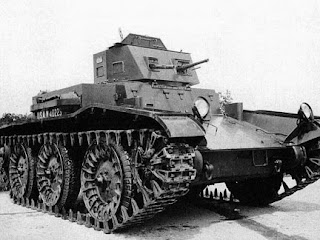One of the unusual stories from the interwar period (1919 - 1941 for the United States) is the passing of the National Defense Act of 1920. Sponsored by Julius Kahn this piece of legislation reorganized the United States Army and modified the rules on procurement and acquisitions, aiming to decentralize the process. The National Defense Act of 1920, to my eye, has its greatest impact in how it influenced the development of tanks in the United States between World War I and World War II, due to a key technical requirement of the bill, that tanks were to be subordinated to the needs of the Army. During World War I the United States had played with the idea of a separate Tanks Corps but after the war decided to focus in on tanks serving in an infantry support roll.
This, frankly, annoyed two leading United States military figures, Patton and Eisenhower, because it would strip tanks of their mobility potential and instead put them on the path of being rolling infantry support vehicles. Congress however was firm on this point and also reduced the available budget for tank development to a bare minimum, forcing the army to pour its development dollars in the 1920s into vehicles like the one pictured above, the M2, a slow, under armed, mobile gun platform with an emphasis on machine guns to cut down advancing infantry over heavy cannons to destroy other tanks.
However Douglas MacArthur was made Chief of Staff of the United States Army and MacArthur wanted the United States Army to focus on being a faster, more mobile, and more nimble force. He also wanted to develop tanks that focused on mobility and anti-tank capacity over lumbering along behind the infantry with a wad of machine guns. But Congress had forbidden any development of tanks except by the Army, so what was a newly appointed general to do?
As it turns out, engage in some legal trickery. The top image, and the one just above, are of respectively the T7 Combat Car and the M1 Combat Car. Nearly identical to tanks they were developed by the United States Cavalry and use of development dollars was permitted because MacArthur told the Congress, with a straight face, that these weren't tanks. No, these were "combat cars" - use they had armor, they had treads, and they had guns, but they were "cars" not tanks. In fact the T7 Combat Car pictured at the top was built so it could be converted from treads to rubber tires, so it could flexibly roll along paved roads and then switch to an off-road tracked configuration.
This focus by Congress on cost-savings, and pinching military development funds during the interwar period, did help reduce the federal budget but it also led to the United States entering World War II with some, speaking frankly, really shitty tanks. What you see above is the M3 Medium Tank, the Grant, which was obsolete at the start of the war and featured the terrible design flaw of many western tanks of the period, putting the heavy armament in a fixed side turret because fully rotating top turrets were hard to make work well. The problem with this design is if your enemy happens to have a tank with a moving turret they have a better chance of lining up your non-cannon side for a kill shot. (Note the awesome side mounted machine guns though.)
The United States did eventually hammer the issues out, with the design of the M4 Sherman, but it was made under pressure of war. The United States also never really got into the business of real heavy tanks until World War II was nearly over, leading to some very lopsided tank engagements in 1944 through 1945 with the German army.
But I remain convinced it all hinges on the 1920 National Defense Act and how Congress shifted the focus of the United States military towards a fun-sized cost-saving military plan.
Sources: Wikipedia articles on U.S. Tank Development History, the 1920 National Defense Act, the T7 Combat Car, the M1 Combat Car, and U.S. Army Military history journal entry on the Birth of the Armored Forces







